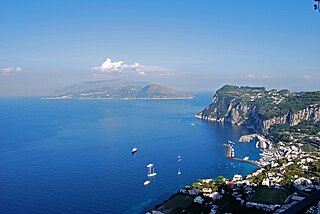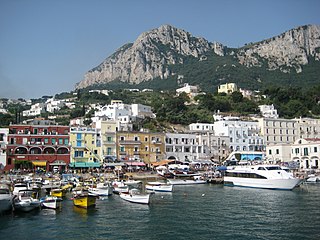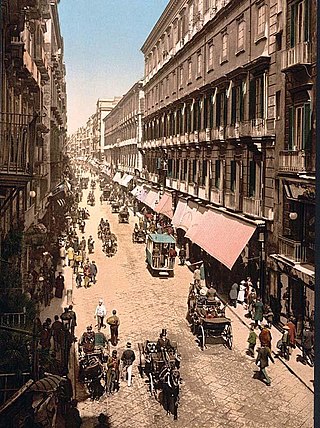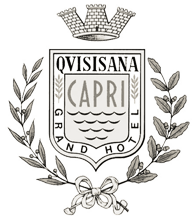
Capri is an island located in the Tyrrhenian Sea off the Sorrento Peninsula, on the south side of the Gulf of Naples in the Campania region of Italy. The main town of Capri that is located on the island shares the name. It has been a resort since the time of the Roman Republic.

A town square is an open public space, commonly found in the heart of a traditional town but not necessarily a true geometric square, used for community gatherings. Related concepts are the civic center, the market square and the village green.

Anacapri is a comune on the island of Capri, in the Metropolitan City of Naples, Italy.

Casale Monferrato is a town in the Piedmont region of Italy, in the province of Alessandria. It is situated about 60 km (37 mi) east of Turin on the right bank of the Po, where the river runs at the foot of the Montferrat hills. Beyond the river lies the vast plain of the Po valley.

Piazza del Plebiscito is a large public square in central Naples, Italy.

Vomero is a bustling hilltop district of metropolitan Naples, Italy — comprising approximately two square kilometres (0.77 sq mi) and a population of 48,000.

Pacentro is a comune of 1,279 inhabitants of the province of L'Aquila in Abruzzo, Italy. It is a well-preserved historic medieval village located in central Italy, several kilometers from the City of Sulmona about 170 kilometres (110 mi) east of Rome. Pacentro has been nominated as one of the "Borghi più belli d'Italia".

Capri is a municipality in the Metropolitan City of Naples situated on the island of Capri in Italy. It comprises the centre and east of the island, while the west belongs to Anacapri.

Piazza della Repubblica is a city square in Florence, Italy. It was originally the site of the city's forum; then of its old ghetto, which was swept away during the improvement works, or Risanamento, initiated during the brief period when Florence was the capital of a reunited Italy—work that also created the city's avenues and boulevards. At that time, the Loggia del Pesce from the Mercato Vecchio was also moved to Piazza Ciompi. The square's Giubbe Rosse cafe has long been a meeting place for famous artists and writers, notably those of Futurism.

Via Toledo is an ancient street and one of the most important shopping thoroughfares in the city of Naples, Italy. The street is almost 1.2 kilometres (0.75 mi) long and starts at Piazza Dante and ends in Piazza Trieste e Trento, near Piazza del Plebiscito.

Via Krupp is a historic hairpin turn paved footpath on the island of Capri, connecting the Charterhouse of San Giacomo and the Gardens of Augustus area with Marina Piccola. Commissioned by the German industrialist Friedrich Alfred Krupp, the path covers an elevation difference of about 100 m (330 ft).

Marina Grande is the main port of the island of Capri in Italy, to the north of the main town of Capri and at the foot of Mount Solaro.

Marina Piccola is located on the southern side of the island of Capri. It is near the Faraglioni sea stacks to the southeast. The Via Krupp is a historic switchback paved footpath which connect the Charterhouse of San Giacomo and the Gardens of Augustus area with Marina Piccola. The Marina Piccola, used by Augustus and Tiberius, preceded the Marina Grande.
Count Gennaro Arcucci was an Italian physician, antiquarian and a hero of the island of Capri and Caprese martyr in the Bourbon Restoration of Ferdinand I. He was said to have been the principal signori of the island who used to "entertain the King during his visits to the island and offer him draughts of his far-famed 'Tears of Tiberius'". He was hanged by the Bourbons in 1800, "as a 'liberal'". A plaque commemorates him on the Piazza Umberto I.

The Grand Hotel Quisisana is the largest hotel on the island of Capri. It is located in the old town of Capri, opposite to the Hotel Residenza Capri and the Villa Sanfelice, to the south of the Piazza Umberto I. It was founded as a sanatorium in 1845 by the British doctor George Sidney Clark, who turned it into the Grand Hotel Quisisana in 1861. "Qui si sana" means "here one heals" in Italian.

Santo Stefano is a Catholic church and former cathedral on the island of Capri, Italy. Dedicated to Saint Stephen, it is the principal house of worship in the town of Capri. The religious complex was built around the Piazza Umberto I square in the seventeenth century. The archbishop's palace is now used as the town hall ("Municipio"). Santo Stefano and Chiesa di San Costanzo are the island's two oldest churches.
JK Place Capri is a luxury boutique hotel on island of Capri. It is located in the northeast of Anacapri town, towards the northwest of the island and west of Marina Grande. Established in 2007, the hotel has 22 rooms, and eight suites, and is situated in a restored late 19th century villa which once belonged to wealthy American sisters Sadiee and Kate Woolcott-Perry.
Villa Solitaria, also known as Casa Solitaria or La Solitaria, is a national historic house built between 1907 and 1910 via del Pizzolungo on the island of Capri by Edwin Cerio (1875–1960), a prominent Italian writer, engineer, architect, historian, and botanist

The Piazza Tasso massacre was a massacre that occurred on July 17, 1944, at Piazza Tasso in Florence, Tuscany, Italy.
The following is a timeline of the history of the city of Reggio Calabria, Italy.


















